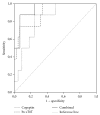Copeptin testing in acute myocardial infarction: ready for routine use?
- PMID: 25960596
- PMCID: PMC4415476
- DOI: 10.1155/2015/614145
Copeptin testing in acute myocardial infarction: ready for routine use?
Abstract
Suspected acute myocardial infarction is one of the leading causes of admission to emergency departments. In the last decade, biomarkers revolutionized the management of patients with suspected acute coronary syndromes. Besides their pivotal assistance in timely diagnosis, biomarkers provide additional information for risk stratification. Cardiac troponins I and T are the most sensitive and specific markers of acute myocardial injury. Nonetheless, in order to overcome the remaining limitations of these markers, novel candidate biomarkers sensitive to early stage of disease are being extensively investigated. Among them, copeptin, a stable peptide derived from the precursor of vasopressin, emerged as a promising biomarker for the evaluation of suspected acute myocardial infarction. In this review, we summarize the currently available evidence for the usefulness of copeptin in the diagnosis and risk stratification of patients with suspected acute myocardial infarction in comparison with routine biomarkers.
Figures


Similar articles
-
Use of copeptin in emergency patients with cardiac chief complaints.Eur Heart J Acute Cardiovasc Care. 2015 Oct;4(5):393-402. doi: 10.1177/2048872614554197. Epub 2014 Oct 15. Eur Heart J Acute Cardiovasc Care. 2015. PMID: 25318480
-
Use of copeptin and high-sensitive cardiac troponin T for diagnosis and prognosis in patients with diabetes mellitus and suspected acute myocardial infarction.Int J Cardiol. 2015;190:190-7. doi: 10.1016/j.ijcard.2015.04.134. Epub 2015 Apr 17. Int J Cardiol. 2015. PMID: 25920022
-
Correlation of plasma copeptin levels and early diagnosis of acute myocardial infarction compared with troponin-T.J Med Assoc Thai. 2013 Jan;96(1):13-9. J Med Assoc Thai. 2013. PMID: 23720972
-
Copeptin as a biomarker in cardiac disease.Curr Top Med Chem. 2013;13(2):231-40. doi: 10.2174/15680266113139990088. Curr Top Med Chem. 2013. PMID: 23470080 Review.
-
Use of copeptin for rapid rule-out of acute myocardial infarction.Eur Heart J Acute Cardiovasc Care. 2018 Sep;7(6):570-576. doi: 10.1177/2048872617710791. Epub 2017 Jun 8. Eur Heart J Acute Cardiovasc Care. 2018. PMID: 28593800 Review.
Cited by
-
Performance of Copeptin for Early Diagnosis of Acute Myocardial Infarction in an Emergency Department Setting.Ann Lab Med. 2020 Jan;40(1):7-14. doi: 10.3343/alm.2020.40.1.7. Ann Lab Med. 2020. PMID: 31432633 Free PMC article.
-
Complementary Role of Oxytocin and Vasopressin in Cardiovascular Regulation.Int J Mol Sci. 2021 Oct 24;22(21):11465. doi: 10.3390/ijms222111465. Int J Mol Sci. 2021. PMID: 34768894 Free PMC article. Review.
-
An update of new/potential cardiovascular markers: a narrative review.Mol Biol Rep. 2024 Jan 22;51(1):179. doi: 10.1007/s11033-023-08978-1. Mol Biol Rep. 2024. PMID: 38252393 Review.
-
Early myocardial injury biomarkers in diabetic hyperlipidemic rats: Impact of 10-dehydrogingerdione and vitamin D3.Exp Biol Med (Maywood). 2020 Sep;245(15):1326-1334. doi: 10.1177/1535370220943124. Epub 2020 Jul 19. Exp Biol Med (Maywood). 2020. PMID: 32686474 Free PMC article.
-
Copeptin, miRNA-208, and miRNA-499 as New Biomarkers for Early Detection of Acute Coronary Syndrome.Appl Biochem Biotechnol. 2022 Mar;194(3):1193-1205. doi: 10.1007/s12010-021-03695-6. Epub 2021 Oct 12. Appl Biochem Biotechnol. 2022. PMID: 34637111 Review.
References
-
- Thygesen K., Alpert J. S., Jaffe A. S., et al. Third universal definition of myocardial infarction. European Heart Journal. 2012;33(20):2551–2567. - PubMed
-
- Hamm C. W., Bassand J.-P., Agewall S., et al. ESC guidelines for the management of acute coronary syndromes in patients presenting without persistent ST-segment elevation: the Task Force for the management of acute coronary syndromes (ACS) in patients presenting without persistent ST-segment elevation of the European Society of Cardiology (ESC) European Heart Journal. 2011;32(23):2999–3054. doi: 10.1093/eurheartj/ehr236. - DOI - PubMed
Publication types
MeSH terms
Substances
LinkOut - more resources
Full Text Sources
Other Literature Sources
Medical

